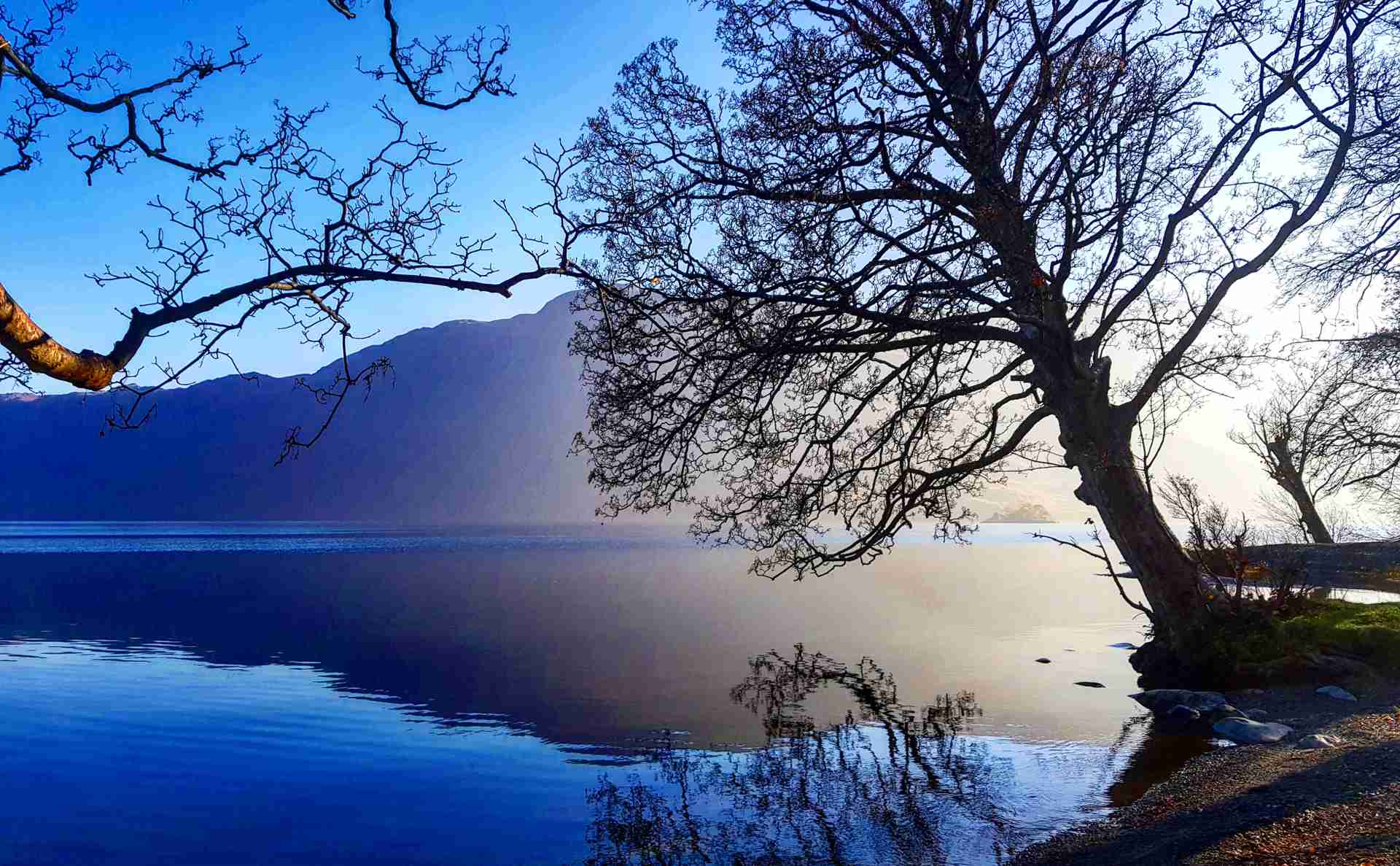
Ullswater
.jpg)
Castlerigg Stone Circle
.jpg)
From 'Suprise View'
.jpg)
Buttermere
.jpg)
Buttermere
.jpg)
Honister Pass
Aira Force

Full Day 120.00 per person
Book this tourCheck AvailabilityThis full day, all-inclusive tour will take you to the north western Lake District for spectacular scenery, fascinating heritage sites, nine lakes and three mountain passes in just a single day.
Your day starts with a climb, all the way up to the Kirkstone Inn,the highest inhabited building in the Lake District, for a stop to take in the views back down the valley right the way down to Lake Windermere and Ambleside. This once important coaching inn sits almost at the summit of the Lake District's highest pass that is open to motor traffic.
From here the road plunges down into the Kirkstone Pass properly with the valley walls rising up steeply on either side, past the church shaped rock from which the valley gets its name and on to the viewpoint for a photo stop of the ribbon of road as it descends down to Brothers Water. This lake was one of the first places in the Lakes to be acquired by the National Trust.
The thin strip of road winds past the lake, down to the Ullswater valley and on to the charming and popular village of Patterdale. This the starting point for a number of popular hill-walks, most notably the Striding Edge path up to Helvellyn, the third highest mountain in the Lakes. The only other village in this valley is Glenridding and it is here that we get our first glimpse of the National Park's second largest lake, Ullswater. We will stop on the lake shore for photographs.
We leave Ullswater and head north and west towards Keswick. As we pass the impressive mountains and fells, looking up at Blencathra one cannot help but be moved by its shear scale, and those slender fingers of rock running southwards from its high ridge line must either frighten, or excite. Blencathra is one of the most northerly mountains in the Lakes with six separate fell tops, the highest standing at 868-metres. One of the famous features of Blencathra is the steep ridge called Sharp Edge which you will see as we pass the foot of the mountain. This is a walker's paradise and some of the fells in this area are challenging and difficult even on a mild summer's day. Your next stop is right in among these rugged mountains at one of the most spectacularly located Neolithic stone circles anywhere, Castlerigg.
Castlerigg Stone Circle stands on a superb natural plateau commanding a superb 360 degree view over the surrounding fells. Made up of 38 free standing stones, some up to 3 metres (10 feet) high, it is one of Britain's earliest stone circles dating back to the Neolithic period 4000 to 5000 years ago. The spectacular and atmospheric location will take your breath away but we only have a short stop here before we head onwards to the shores of Derwentwater for your next destination.
Our journey now takes us a short distance to the head of Derwentwater where we stop at Lakeside near Keswick, for lunch. This is a tiny, hidden corner of the Lakes with lots going on. The theatre here, hailed by The Independant newspaper as "the most beautifully located and friendly theatre in Britain", opened in 1999. It sits only a short stroll from Derwentwater on the edge of Keswick, amid the magnificent western fells of the Lake District. The Lakeside Café Restaurant is perched between the theatre and Derwentwater. Lofty, light and airy, its large windows give spectacular views across the lake to Cat Bells and beyond, it's the perfect setting for you to enjoy lunch.
After lunch, dependant upon the weather conditions, your guide may take you for a short stroll along the shores of Derwentwater to Friars Crag. This is a promontory jutting into Derwentwater on a stretch of shore about half a mile from the boat landing stages. Ruskin described the view as one of the three most beautiful scenes in Europe. The path from the Lakeside café is easy, taking us along the shore line, with clear views over to Derwent Isle, and across the lake to Brandlehow Woods, the first property acquired by the National Trust in the Lake District.
We now travel to 'Surprise View', weather permitting, one of the most stunning viewpoints in the Lake District. From here you can see Derwentwater, one of the principal bodies of water in the Lakes. Derwentwater has four permanent islands: Derwent, Lord's, Rampsholme and St. Herbert's. It also has (reputedly) one floating island which sporadically appears towards the end of summer consisting of a mass of vegetable matter that rises to the surface on a cushion of methane gas! Visitors have flocked here for generations to admire the beauty and climb the fells. Two of the favourite holiday homes of Beatrix Potter, Lingholm and Fawe Park, lie on the far shore of Derwentwater. The lake was also used as a filming location for the 2015 Star Wars blockbuster 'The Force Awakens'.
We then drop down the hill to Ashness Bridge, one of the most photographed packhorse bridges in the Lakes.
Onwards through the Borrowdale Valley, the road now rises higher and higher as we climb the fell to the Honister Slate Mine at the head of the pass. We have a brief stop here for you to capture the view down the valley on your camera. Passing the slate sculptures of the Guardians of the Pass, we now climb slowly down the steep track as it twists and turns into the Honister Pass itself. Beautiful, remote and desolate, the pass winds through the fells, the green-tinged slate shining in the sun and the curved rock faces looming above us.
The pass itself connects the Buttermere valley with the eastern end of the Borrowdale valley. Rising to 1167 feet in height at the summit, it is one of Cumbria's highest passes, with a gradient of 1 in 4. Flowing through the pass from the summit to Buttermere is Gatesgarthdale Beck and in the valley bottom we stop for another photo opportunity.
Buttermere could not be more of a contrast to the magnificent yet hard scenery of Honister. We are now entering the Vale of Lorton, one of the lushest and prettiest parts of the Northern Lakes, the valley contains the lakes Loweswater, Crummock Water and Buttermere. Driving down the eastern shores of the Buttermere with the sun glinting off the water is one of the loveliest places to be in the Lakes; it is still beautiful even in the rain.
From here we turn right to head up to Moss Force waterfall and then onwards into the Newlands Valley
We now head back towards Keswick and start the journey down towards Ambleside. On the way you will pass Thirlmere, and at the foot of the water, we then head back along your fourth, and last, mountain pass of Dunmail Raise.
Now the road drops steadily down from the fells and before long, we pass Grasmere village to drive along the shores of Grasmere, your ninth lake. William Wordsworth lived here at Dove Cottage and as we continue on, we pass Nab Cottage, the home of his friend and author, Thomas de Quincey. The road winds along the shore until we come to Rydal Water, your tenth and final lake. The water here is often mirror-like still with beautiful reflections of the surrounding fells. We pass Wordsworth's last and favourite home which is situated off the road at Rydal as we return to Ambleside for the first of our drop-off points.
Due to the weather being unpredictable, the actual route of this tour is subject to change on the day
The English Lake District weather can change quickly, even in the summer months. Please bring a waterproof coat with a hood in case of rain or windy weather.
As there is some walking involved in the tour, some uphill and on uneven or wet terrain, please wear suitable, comfortable shoes.
This tour is not suitable for children under the age of 5.
No food or drink is included in this tour price.
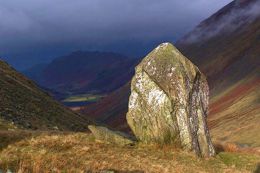
Kirkstone Pass with an altitude of 1,489 feet is the Lake District's highest pass that is open to motor traffic. The Kirkstone Pass Inn stands close to the summit of the pass. Formerly an important coaching inn, it now caters primarily for tourists and is the third highest public house in England.
Near the top of the pass is Kirkstone Quarry (below), where rock extraction and architectural stone production took place over 500m above sea level. Further production facilities for bespoke items such as work surfaces, head office and trade showroom were located at Skelwith Bridge near Ambleside. The main materials mined were green and blue-black slate. The former, a unique composition of volcanic material layered down some 450 million years ago, is found only in relatively small deposits within the Lake District. Intense compression led to metamorphosis into a dense and highly durable rock with great lateral strength. The latter took on a much more common geological formation, being an accumulation of dense and deeply compressed sedimentary material formed some years after the volcanic period, deep in the rifts of the earth's surface.
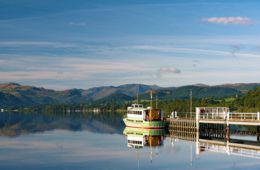
This lovely lake is surrounded by stunning mountain scenery to its south, softening to the gentle hills of the north. The lake is the second largest in England at seven and a half miles long, but is less than a mile across. It is also the third deepest English lake at 250 feet deep. It has three distinct bends giving it a dog's leg appearance. Ullswater is clear but deep, and in the deepest part lives a curious fish called the skelly, a sort of freshwater herring.
There are dramatic views from both sides of the lake, by foot or by vehicle. The small village at the foot of Ullswater, Glenridding, is a popular starting point for walkers and climbers going up Helvellyn, England's third highest mountain including Striding Edge and Swirral Edge. Further along the lake is Glencoyne Park. It was here that William and Dorothy Wordsworth were walking on 15 April 1802, when the location gave him the inspiration to write his most famous poem, 'Daffodils'.
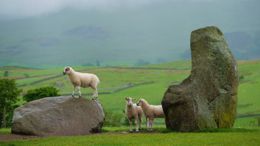
Castlerigg is perhaps the most atmospheric and dramatically sited of all British stone circles, with panoramic views and the mountains of Helvellyn and High Seat as a backdrop. It is also among the earliest British circles, raised in about 3000 BC during the Neolithic period. The most visited stone circle in Cumbria, every year thousands of people visit it to look, photograph, draw and wonder why and when and by whom it was built. The stone circle itself is on the level top of a low hill with views across to Skiddaw, Blencathra and Lonscale Fell.
There are 38 stones in a circle approximately 30 metres in diameter. Within the ring is a rectangle of a further 10 standing stones, the tallest stone is 2.3 metres high. The site is important in terms of megalithic astronomy and geometry, as the construction contains significant astronomical alignments. Although its origins are unknown it is believed that it was used for ceremonial or religious purposes.
There is a lot going on in this small corner of the Keswick area. Not only is there a theatre and a café/restaurant, but at the boat landing stage, you can purchase duck food for 50p from either the steamer boat house, or the National Trust shop opposite. A short walk away from the lake up the road that leads past the café, theatre, and car park is the entrance to Hope Park. Here there are remote control steamer boats that can be used for £1, and a crazy golf course. There may be just time for you to have a quick look but as there is so much more still to come on the tour, we cannot linger here.
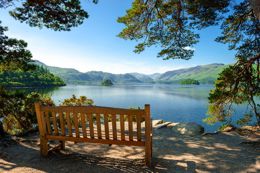
Friars Crag achieved its name because it was believed to be the embarkation point for monks making a pilgrimage to St Herbert's Island, located south west of the crag. It was through the efforts of Canon Rawnsley, vicar of Crosthwaite and one of the founders of the National Trust that much of Borrowdale was preserved from development. On his death in 1920 Friars Crag, together with Lords Island and Calf Close Bay were given to the Trust as his memorial. A plaque to his memory is set into a wall beside the Friars Crag Path. Also at Friars Crag is a memorial, unveiled in 1900, to John Ruskin, who had many associations with Keswick. He once said Keswick was a place almost too beautiful to live in.
Located at the head of Honister Pass in the heart of the Lake District, Honister Slate Mine produces the world famous Westmorland Green Slate a beautiful, functional 450 million year old material that has been extracted here for centuries. For well over 300 years slate from the Honister quarries was carried by pack-horse across the high mountains to the Cumberland coast. This involved an extremely hazardous journey on steep terrain. The route the pack trains took can still be followed today and occasionally along the way one can see deposits of broken slates showing where a load slipped and the fragile contents were lost. The route is still known as 'Moses' Trod' after the quarryman, Moses Rigg, who, as well as being a skilled slate worker, operated a profitable sideline of carrying and distributing smuggled whisky from the coast which he stored in the workings on Honister Crag.
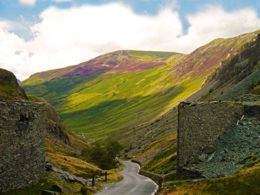
For hundreds of years the only means of transport of goods between the Lake District valley communities was by pack ponies that used well established pack-horse routes across high mountain passes. These routes frequently ran from the heads of valleys and the valley-head farms became important staging points for the ponies. Although the high level tracks were well graded, they could become very dangerous in bad weather. It was only in the 19th C that improved roads removed the need for this type of transport but even today many valley-head farms are still very isolated with the only visitors being walkers passing through heading along the fells.
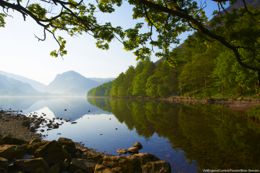
Buttermere, the lake by the dairy pastures, is 1 1/2 miles long, 3/4 of a mile wide and 75 feet deep. The classic combination of lakes and mountains has made this popular with visitors since the beginning of tourism in the Lake District. A visit to Buttermere is principally for its natural attractions as the area offers some of the best walking country in the Lake District. In the little Church of St James, is a stone tablet set into the windowsill of a south window as a memorial to Alfred Wainwright, the famous walker and author of guidebooks. The window looks out on his favourite place to walk, Haystacks, where at his wish his ashes were scattered.
Buttermere village is a small hamlet situated between the lakes Buttermere and Crummock Water, which were originally one post-glacial lake. The land was created by the debris washed down from the surrounding hills. Buttermere lake is owned by The National Trust, and is 1½ miles long, ¾ mile wide and 75 feet deep.
There is a popular local story about Mary Robinson, the stunning daughter of the Fish Hotel's landlord, became known as the "Beauty of Buttermere", and in 1802 she married Lieutenant-Colonel the Hon. Alexander Augustus Hope. Unfortunately he was an imposter and bigamist who was subsequently hanged in Carlisle, not for bigamy but forgery! Her story has been told in several novels, most recently by Melvyn Bragg in "The Maid of Buttermere".
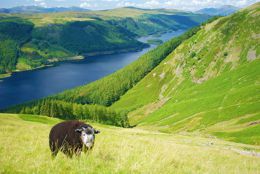
which was originally two smaller lakes, which were purchased by Manchester City Corporation Waterworks in 1889. The area was dammed with a dam whose greatest height is 104 feet, and the area became one vast reservoir. In the process, the settlements of Armboth and Wythburn were submerged.
This is the flattest of the mountain passes in the Lake District running down towards Grasmere. Dunmail Raise is also the name of a large cairn which stands on the top of the pass, on the central reservation between the two carriageways of the road. Legend has it that Dunmail, the last king of Cumberland, is buried beneath the cairn at Dunmail Raise after having been slain by the English in battle.
.jpg)
The village is on the river Rothay which flows into Grasmere (the body of water), which lies about 0.5 km to the south and is overlooked from the north-west by the rocky hill of Helm Crag, popularly known as The Lion and the Lamb or the Old Lady at the Piano. These names are derived from the shape of rock formations on its summit, depending on the side from which you view it.
The lake at Grasmere being one mile long, half a mile wide and 75 feet deep, would be an attractive and popular tourist area even without its Wordsworth connections. 'The most loveliest spot than man hath found' was Wordsworth's famous quote describing the area of Lakeland that he most loved. The small island in the middle of the lake was his favourite destination while he was staying at nearby Dove Cottage.
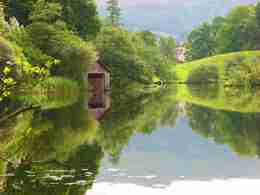
Rydal Water is one of the smallest lakes at three quarters of a mile long, quarter of a mile wide and with a depth of 55 feet, but it is very popular partly because of its Wordsworth connections. Steps lead up from the western end of the lake to 'Wordsworth's Seat', reputedly the poet's favourite viewpoint. Overlooking the lake is Nab Cottage, once home to Thomas Quincey and Hartley Coleridge, the son of Samuel Taylor Coleridge.
To display the available dates for this tour please answer the questions below.
We can accept bookings up to 30 minutes before the departure time from your chosen pickup point, provided that we have availability.
You will not need to print anything out. Just book, read the confirmation email and wait at the pickup point!

Dates that are available for your group size are highlighted below in Orange. To book, simply click on one of these dates and complete the next page with your details.
| October 2025 | ||||||
|---|---|---|---|---|---|---|
| Mon | Tue | Wed | Thu | Fri | Sat | Sun |
| 2 | 3 | 4 | 5 | |||
| 6 | 7 | 8 | 9 | 10 | 11 | 12 |
| 13 | 14 | 15 | 16 | 17 | 18 | 19 |
| 20 | 21 | 22 | 23 | 24 | 25 | 26 |
| 27 | 28 | 29 | 30 | 31 | ||
| November 2025 | ||||||
|---|---|---|---|---|---|---|
| Mon | Tue | Wed | Thu | Fri | Sat | Sun |
| 1 | 2 | |||||
| 3 | 4 | 5 | 6 | 7 | 8 | 9 |
| 10 | 11 | 12 | 13 | 14 | 15 | 16 |
| 17 | 18 | 19 | 20 | 21 | 22 | 23 |
| 24 | 25 | 26 | 27 | 28 | 29 | 30 |
| December 2025 | ||||||
|---|---|---|---|---|---|---|
| Mon | Tue | Wed | Thu | Fri | Sat | Sun |
| 1 | 2 | 3 | 4 | 5 | 6 | 7 |
| 8 | 9 | 10 | 11 | 12 | 13 | 14 |
| 15 | 16 | 17 | 18 | 19 | 20 | 21 |
| 22 | 23 | 24 | 25 | 26 | 27 | 28 |
| 29 | 30 | 31 | ||||
| January 2026 | ||||||
|---|---|---|---|---|---|---|
| Mon | Tue | Wed | Thu | Fri | Sat | Sun |
| 1 | 2 | 3 | 4 | |||
| 5 | 6 | 7 | 8 | 9 | 10 | 11 |
| 12 | 13 | 14 | 15 | 16 | 17 | 18 |
| 19 | 20 | 21 | 22 | 23 | 24 | 25 |
| 26 | 27 | 28 | 29 | 30 | 31 | |
| February 2026 | ||||||
|---|---|---|---|---|---|---|
| Mon | Tue | Wed | Thu | Fri | Sat | Sun |
| 1 | ||||||
| 2 | 3 | 4 | 5 | 6 | 7 | 8 |
| 9 | 10 | 11 | 12 | 13 | 14 | 15 |
| 16 | 17 | 18 | 19 | 20 | 21 | 22 |
| 23 | 24 | 25 | 26 | 27 | 28 | |
| March 2026 | ||||||
|---|---|---|---|---|---|---|
| Mon | Tue | Wed | Thu | Fri | Sat | Sun |
| 1 | ||||||
| 2 | 3 | 4 | 5 | 6 | 7 | 8 |
| 9 | 10 | 11 | 12 | 13 | 14 | 15 |
| 16 | 17 | 18 | 19 | 20 | 21 | 22 |
| 23 | 24 | 25 | 26 | 27 | 28 | 29 |
| 30 | 31 | |||||